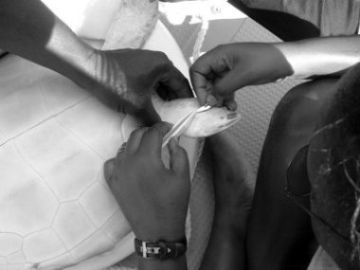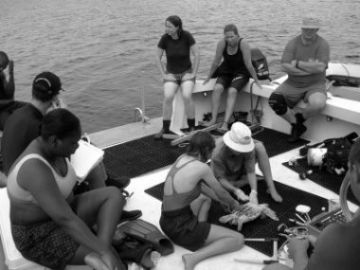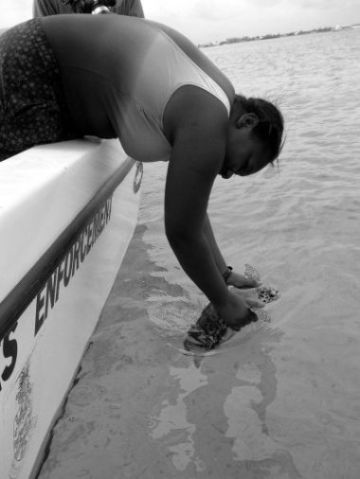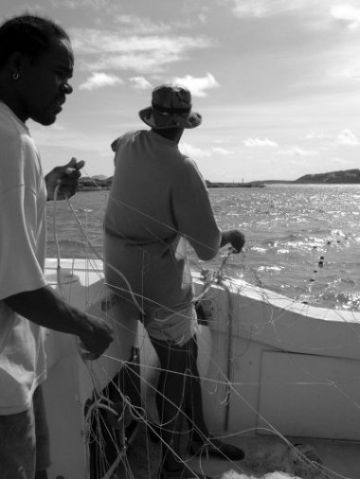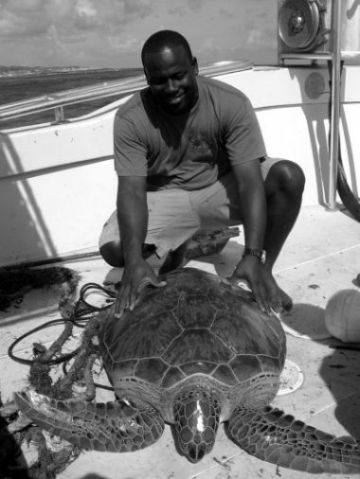Peter Richardson, Species Policy Officer (peter{at}mcsuk.org)
Sue Ranger, Wildlife Projects Officer (sue{at}csuk.org)
Marine Conservation Society (MCS), 9 Gloucester Rd, Ross on Wye, Herefords, HR9 5BU.
An outline of the presentation given to the BCG Northern Symposium at Chester Zoo on 12th October 2002.
Since November 2001, the Marine Conservation Society (MCS) has been working with the Marine Turtle Research Group (MTRG, University of Wales, Swansea) to coordinate a 3-year project known as Turtles in the Caribbean Overseas Territories (TCOT). TCOT seeks to assess the status and exploitation of marine turtle populations in the UK Overseas Territories in the Caribbean.
In recent years the exploitation of marine turtles in the Caribbean has generated an extraordinary level of international concern, primarily due to Cuba’s repeated efforts to reopen the international trade in hawksbill shell under the Convention of International Trade in Endangered Species (CITES). As a result of the emotionally charged debate surrounding Cuba’s efforts, CITES initiated a Wider Caribbean Hawksbill Turtle Range State Dialogue Process. This process has led to a general agreement among Range States to work towards a regional management strategy for the hawksbill turtle in the Caribbean. In line with this agreement, the UK Government commissioned TCOT to address critical gaps in the knowledge of marine turtle populations found in the UK Overseas Territories in the Caribbean.
Throughout these Territories there is a diversity of attitudes to marine turtles and their conservation. In Anguilla and Bermuda marine turtles are fully protected, whereas in the British Virgin Islands, Cayman Islands, Montserrat and the Turks and Caicos there are still legal harvests. For example, in the Turks and Caicos Islands, all parts of hawksbill and green turtles, except the carapace, have some nutritional value. The meat is used for steaks and stew, the head, intestines and organs are cleaned and boiled in stew and the plastron is boiled down into a rich jelly. Undeveloped eggs taken from harvested breeding females are either boiled and eaten as a delicacy or blended with rum to make a drink believed to have invigorating powers. Even the turtle penis, soaked in rum, is considered to be a potent aphrodisiac by some Turks & Caicos Islanders.
Turtle fishing appears not to be the main source of income for the majority of fishermen in the Turks & Caicos Islands, they prefer to catch the fleshy queen conch and spiny lobsters that fetch a good price on the export market. But if the opportunity arises, the fishermen will catch turtles and sell the meat to local residents and some local restaurants, where turtle stew is high on the menu. Despite the legislation, monitoring of the turtle harvests in most of the UK Overseas Territories in the Caribbean is inadequate and therefore the effect of these harvests on Caribbean marine turtle populations is unknown.
From the outset, MCS and MTRG decided that TCOT could only understand the dynamics of marine turtle harvest in the Overseas Territories through a partnership approach. TCOT involves a coalition of project partners and is working in association with the University of Western Ontario, University of Wales Cardiff, the Cayman Turtle Farm and the Cayman Islands Department of Environment. In the Territories, TCOT is also working with the Department of Fisheries and Marine Resources and the Anguilla National Trust in Anguilla; the Bermuda Turtle Project and the Ministry of Environment in Bermuda; the Department of Conservation and Fisheries, H. Lavity Stoutt Community College and the BVI National Trust in the British Virgin Islands; the Montserrat National Trust and the Department of Fisheries of Montserrat and the Department of Environment and Coastal Resources in the Turks and Caicos Islands. TCOT is co-funded by the Department of Environment and Rural Affairs (Defra) and the Foreign and Commonwealth Office Environment Fund for the Overseas Territories, with support also coming from Cheltenham & Gloucester and the various project partners.
TCOT has initiated a number of research programmes in each Territory including nesting beach and foraging site monitoring, genetic stock analysis, PIT (Passive Integrated Transponder) and flipper tagging, socio-economic surveys and volunteer programmes involving dive operators and tourists. The methods employed in this research were standardised between the project partners at a TCOT training workshop held in August 2002 by the Cayman Turtle Farm and the Cayman Department of Environment in Grand Cayman.
The data collected from the research programmes will be analysed to form the basis of a series of Territory-specific reports, which will provide a contemporary evaluation of the status of marine turtle populations and will include recommendations for future marine turtle management and research in each Territory. These recommendations will be submitted to the each Territory government and the UK Government in October 2004 in order to inform their positions with respect to the CITES Hawksbill Turtle Range State Dialogue Process.
The BCG is also supporting TCOT and has generously provided a grant of £500 to the Anguilla Department of Fisheries and Marine Resources (DFMR). Anguilla has imposed a temporary moratorium on all turtle fishing since 1995 and the DFMR has confiscated many of the nets that the turtle fishers traditionally used, which have degraded over the years they have been in storage. Now the Department needs turtle nets to catch green and hawksbill turtles for genetic sampling, tagging and release in order to get an idea of the local trends of the foraging populations for these species. The BCG grant has allowed the Department to employ a former turtle fisherman to weave two new nets to be used by the Department in the TCOT research and James Gumbs, the DFMR marine biologist, will be reporting on the progress of his TCOT research in a forthcoming issue of Testudo.
For more information on TCOT, go to www.seaturtle.org/mtrg/projects/tcot
Photos: P. Richarson/MCS
Testudo Volume Five Number Five 2003
Top

